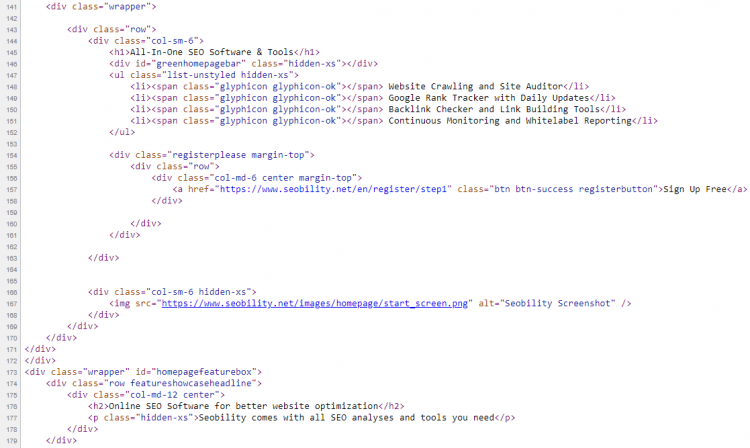HTML5
Contents
Definition
HTML5 is a type of computer language whose main function is to present web content in a standardized way. HTML stands for hypertext markup language, which is the language used to support a variety of elements within a website, from their appearance to the functionality. This language is understood by browsers and its elements serve as instructions so web pages are displayed uniformly across modern browsers.
HTML5 was initially released in 2008 by the W3C. W3C (the World Wide Web Consortium) is an international organization that developed this markup language with the objective of improving web accessibility and functionality.
According to the W3C, HTML5 is a living standard, which means that the language continues to be expanded and updated. Several versions of this HTML language have been released since the initial one, with the latest being version 5.3.

Screenshot with HTML Code of seobility.net
HTML5 vocabulary
Like other languages, HTML5 relies on words, or in this case elements. This HTML version came with a series of new tags or code elements that support the structure of a website. Some of the main elements introduced with this version were:
- The article element, which is used to enclose pieces of content within a web page.
- The aside element, which designates pieces of content marginally related to the rest of the page.
- The figure element, which designates self-contained and often visual content, such as images or diagrams.
- The nav element, which encloses a page’s navigation.
- The header, footer, and section elements, which are self-explanatory.
HTML5 vocabulary is quite extensive, so for a detailed overview, you can visit the official W3C page.
What are the new features of the fifth version of HTML?
In addition to the elements specified in the previous section, HTML5 introduced vocabulary specific to the new functions of the latest W3C standard. An example is the addition of the video element, which allows direct embedding of video content on a web page. Other additions consisted of a series of attributes related to this new element, such as the controls attribute, which allows the adjustment of volume, play and pause from within an embedded video.
The audio element is another new feature. To reproduce audio, previous HTML versions required a plugin, a helper application, or a link to a sound file from within the text. This is no longer the case in the current version.
Additionally, the canvas element was created so that developers can create animations and draw graphics, charts, or shapes. This feature requires the use of JavaScript.
In addition to the new features related to multimedia, semantics, or vocabulary, HTML5 also introduced web performance improvements, such as those related to asynchronous JavaScript, which result in faster response times.
Importance for SEO
The correct use of HTML5 tags is an essential part of on-page SEO. Because this is the recommended W3C standard, search engines scan through those tags to determine the structure and content of a page and use this for ranking purposes. W3C has its own HTML5 validation system, which lets web developers check if their site complies with current standards.
Some of the most important HTML5 elements to include for SEO purposes are header tags (h1, h2, etc.), title, meta description, footer, article, and section.
However, simply having these tags is not enough to improve your ranking. To do so, web developers must follow SEO best practices. For example, the title and meta description tags should be kept within the maximum number of characters recommended. Also, content that appears within the article and section tags must not use keyword stuffing, and it is recommended that header tags include the main keyword.
5. Benefits of HTML5
HTML5 features extended capabilities and unlike previous versions, it does not require additional extensions or third party plugins. In particular, HTML5 offers advantages over the previous version of HTML and of XHTML, which did not have the ability to reproduce multimedia content (like music, video, and audio) natively and instead needed additional media players.
Moreover, the current version allows for offline access and browsing, as web content can be stored or cached offline. In addition, HTML5 now supports the editing of documents online, which improves the functionality and user-friendliness of the world wide web.
Another important benefit is that as long as the browser you use supports this HTML version, websites written in HTML5 will be adaptive and responsive across multiple platforms, from desktop to smart TVs or mobile phones.
Overall, the current HTML standards offer a more enjoyable user experience that can boost website engagement and traffic levels.
Related links
- https://www.w3schools.com/html/default.asp
- https://developer.mozilla.org/en-US/docs/Web/Guide/HTML/HTML5
Similar articles
| About the author |
 |